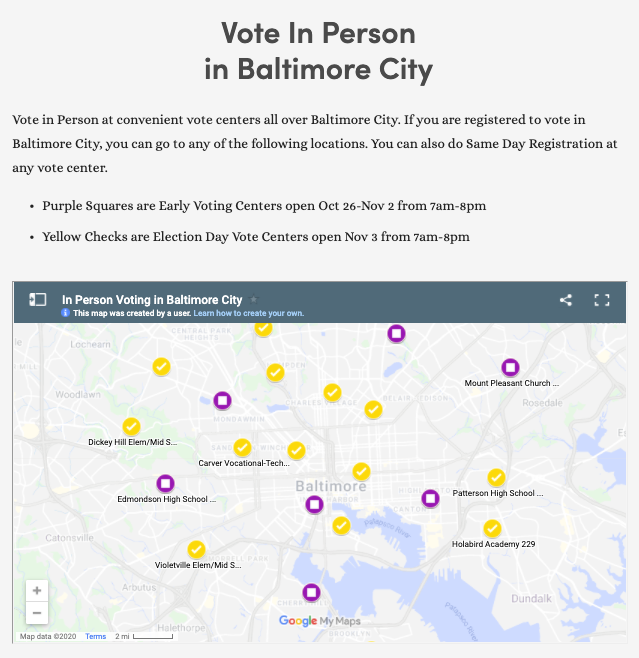Tips for the home stretch: Communicating with voters
This year is testing elections like they have never been tested before. Record turnout. Pandemic. And lots of last-minute changes making it extra hard to get voters the information they need. but we have three quick tips to help you answer voter questions in these last two weeks.
1. Make a map of voting locations
Whether you have just a few early voting centers or hundreds of drop boxes, a map is an easy way to help voters understand their voting options. Voters can find their nearest voting location and get directions quickly.

Google makes it easy to create and maintain the map and embed it on your elections website. It also helps you communicate changes to a wide audience. You can share the embed code with community groups to embed on their own website. And if you make an update, the change will be reflected on their site as well. You can further customize the map:
- Use different markers automatically by types of locations or any other field in your data
- Include details like dates and hours the location is open
- Create layers so you can show sets of locations for specialized maps.
These two guides will get you started:
- Step-by-step instructions of the whole process from the Elections Group
- Video of customizing the Google Map display from Baltimore Votes and CCD
2. Set up an email autoresponse
It’s hard to keep up with email during a busy day. One way to manage the flow is to set up an automated response on your main public email.
You can use an out-of-office message feature to reply to every message you receive. (Or ask your technical support team if there’s another method on your system.) You’ll still get the emails while the server sends an instant reply with answers to voters’ top questions.
Best of all, you can easily adjust the message – every day if you want – to add the latest information, change the information as deadlines pass, or respond to items in the news.
We’ve put together some text, ready for you to customize, including alternative messages to use as deadlines pass. Download the Microsoft Word file to get started.
The text should be short and focus on getting voters to the most important information, that day. For example, information about voter registration might say:
[October ##] is the last day to register to vote in the November 3 election.
– OR –
You can still register at an early voting center or polling place until the end of Election Day, November 3.
– OR –
Registration for the November 3, 2020 election ended on [October ##.] Be ready to vote in the next election and register to vote early.
To make your auto-response effective:
- Reassure the voter that their email will be answered as quickly as you can.
- Start with any recent changes – like new drop boxes, early voting hours, court-ordered changes – at the top, along with any information related to current issues in the news
- Don’t provide too much detail. This isn’t everything on a topic, but the most basic information for the time in the election cycle.
- Link to information pages, but make sure that it’s clear where they can find the form or personalized look-up to take action.
- Spell out shortlinks if you have them so they are easy to read and remember.
3. Add a checklist to your drop boxes
We know that a missing signature is one of the top reasons mail-in ballots can’t be counted. But there are other reasons: missing witness signatures or other information, missing secrecy envelopes, and sometimes things that aren’t obvious (like whether you can use tape to seal the envelope).
By adding a checklist to your drop box, you take advantage of one last opportunity to remind voters about important things that can make the difference between a vote that counts and a vote that doesn’t.

Instead of taping paper on the box, ask your local printer if they can make bumper stickers quickly. We came up with a layout that fits on an 11” x 3” sticker that fits nicely right near the slot on a drop box.
- Focus on reasons the ballot can be rejected. Especially mistakes that many voters make.
- Keep it short. You don’t need a lot of words, just a quick reminder.
- Make it visual. Use icons or illustrations to reinforce the message.
- Keep it positive. Don’t use ALL CAPS or scary warnings.
Resources
- An invitation to certainty: curing an absentee ballot
- Election Administration guides from the Elections Group
- Civic Icons and Images Library on ElectionTools.org
- CCD’s tool kit of resources for scaling up vote-by-mail
- Field Guide Vol. 8 – Guiding voters through the polling place
This was originally published in our Civic Designing newsletter. Subscribe on Mailchimp to get election design tips delivered to your mailbox.

